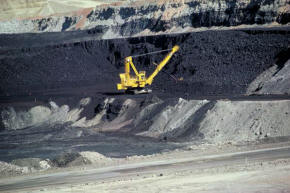Old Earth Ministries Online Earth History Curriculum
Presented by Old Earth Ministries
(We Believe in an Old Earth...and God!)
This curriculum is presented free of charge for use by homeschooling families.
NOTE: If you found this page through a
search engine, please visit the intro page first.
Chapter
7 - The
Carboniferous Period
Lesson 37: Coal
|
|
Coal is a readily
combustible black or brownish-black sedimentary rock normally occurring
in rock strata in layers or veins called coal beds. The harder
forms, such as
anthracite coal, can be regarded as
metamorphic rock because of later exposure to elevated temperature and
pressure. Coal is composed primarily of
carbon
along with variable quantities of other elements, chiefly
sulfur,
hydrogen,
oxygen and
nitrogen.
Coal begins
as layers of plant matter accumulate at the bottom of a body of water. For
the process to continue the plant matter must be protected from
biodegradation and
oxidization, usually by
mud or acidic water. The wide shallow seas of the Carboniferous
period provided such
conditions. This trapped atmospheric carbon in the ground in immense
peat
bogs that eventually were covered over and
deeply buried by sediments under which they metamorphosed into
coal. Over time, the chemical and physical properties of
the plant remains (believed to mainly have been fern-like species
antedating more modern plant and tree species) were
changed by geological action to create a solid material.
Coal, a
fossil fuel, is the
largest source of energy for the generation of electricity
worldwide, as well as one of the largest worldwide
anthropogenic sources
of carbon dioxide
emissions. Gross carbon dioxide emissions
from coal usage are slightly more than those from petroleum and about
double the amount from natural gas. Coal is
extracted from the ground by mining, either
underground or in
open pits.
|
Chapter 7 - The Carboniferous Period
Lesson 36: Overview
Lesson 37: Coal
Lesson 38: Oil
Lessson 39: Species
In-Depth - Synapsids
Test
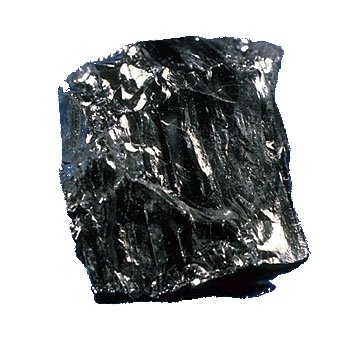
Photo of Anthracite Coal |
|
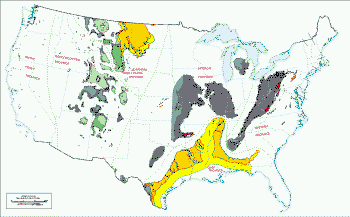
Map of coal reserves in the United States. Click the map for a
larger view. Click
this link to view the source page which contains the map legend.
|
The large coal deposits of the
Carboniferous primarily owe their existence to two factors. The first of
these is the appearance of bark-bearing trees (and
in particular the evolution of the bark
fiber
lignin). The second is
the lower sea levels that occurred during the Carboniferous as compared to
the Devonian period. This
allowed for the development of extensive lowland swamps and forests in North
America and Europe. Some hypothesize that large quantities of wood were buried during
this period because animals and decomposing bacteria had not yet
evolved that could
effectively digest the new lignin. Those early plants made extensive use of
lignin. They had bark to wood ratios of 8 to 1, and even as high as 20 to 1.
This compares to modern values less than 1 to 4. This bark, which must have
been used as support as well as protection, probably had 38% to 58% lignin.
Lignin is insoluble, too large to pass through cell walls, too heterogeneous
for specific enzymes, and toxic, so that few organisms other than
Basidiomycetes fungi
can degrade it. It can not be oxidized in an atmosphere of less than 5%
oxygen. It can linger in soil for thousands of years and inhibits decay of
other substances.
Probably the reason for its high percentages is protection from insect
herbivory in a world containing very effective insect herbivores, but
nothing remotely as effective as modern
insectivores and
probably much fewer poisons than currently. In any case coal measures could
easily have made thick deposits on well drained soils as well as swamps. The
extensive burial of biologically-produced carbon led to a buildup
of surplus oxygen in the
atmosphere; estimates place the peak oxygen content as high as 35%, compared
to 21% today.
This oxygen level probably increased wildfire activity, as
well as resulted in insect and amphibian
gigantism--creatures
whose size is constrained by
respiratory systems
that are limited in their ability to diffuse oxygen.
In eastern North America, marine beds
are more common in the older part of the period than the later part and are
almost entirely absent by the late Carboniferous. More diverse geology
existed elsewhere, of course. Marine life is especially rich in
crinoids and other
echinoderms.
Brachiopods were
abundant. Trilobites became quite
uncommon. On land, large and diverse
plant populations
existed. Land vertebrates included
large amphibians.
Types of Coal
The classification of coal is generally based on the
content of volatiles. However, the exact classification varies between
countries.As
geological processes apply
pressure to dead
biotic material over
time, under suitable conditions it is transformed successively thru
these stages:
|
Peat, considered to
be a
precursor of coal,
has industrial importance as a fuel in some regions, for example,
Ireland and Finland. In its dehydrated form, peat is a highly effective
absorbent for fuel and oil spills on land and water |
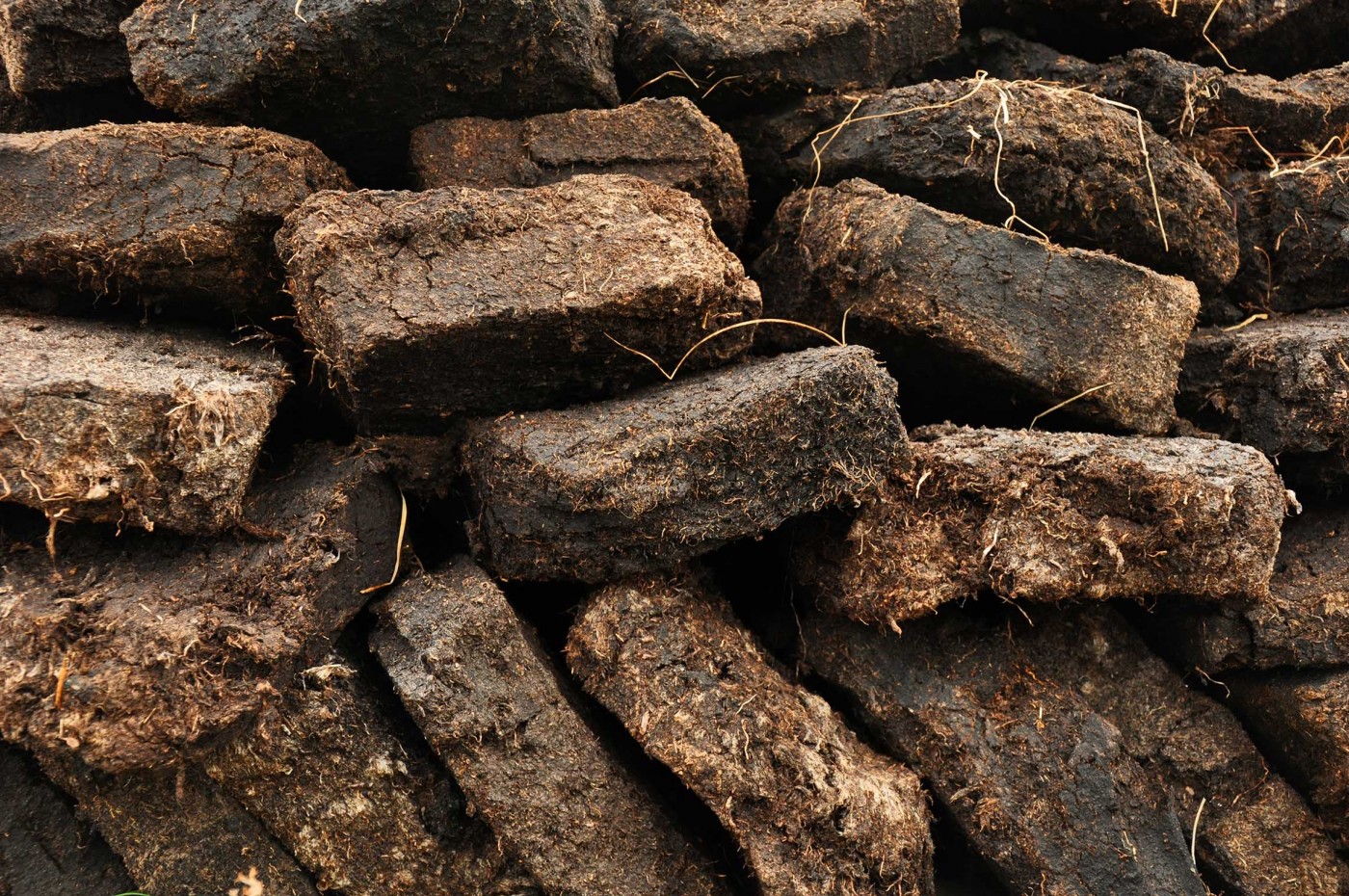 |
|
Lignite, also
referred to as brown coal, is the lowest rank of coal and used almost
exclusively as fuel for electric power generation.
Jet is a compact
form of lignite that is sometimes polished and has been used as an
ornamental stone since the
Iron Age |
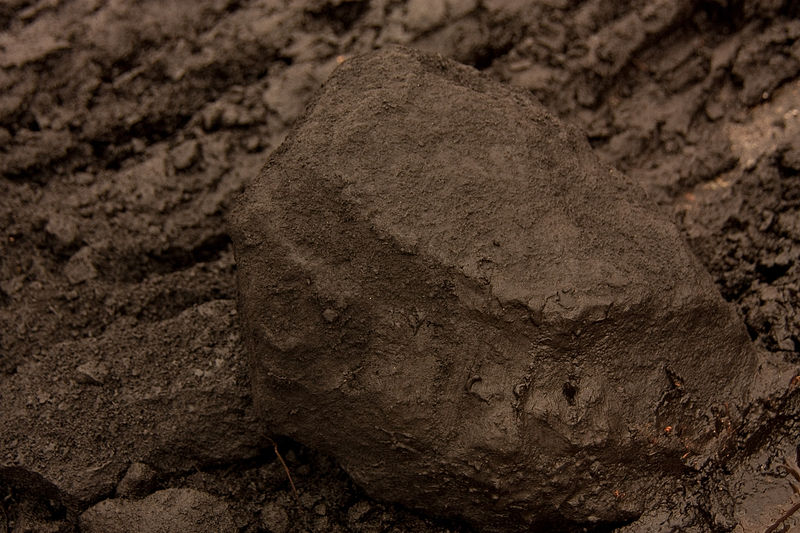 |
|
Sub-bituminous coal,
whose properties range from those of lignite to those of bituminous coal
are used primarily as fuel for steam-electric power generation.
Additionally, it is an important source of light
aromatic hydrocarbons
for the
chemical synthesis
industry. |
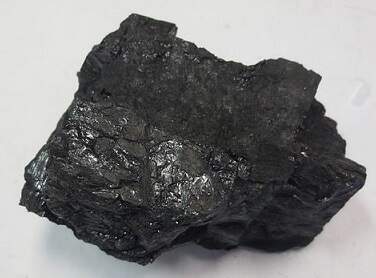 |
|
Bituminous coal,
dense mineral, black but sometimes dark brown, often with well-defined
bands of bright and dull material, used primarily as fuel in
steam-electric power generation, with substantial quantities also used
for heat and power applications in manufacturing and to make
coke |
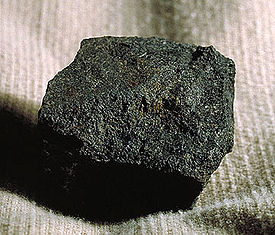 |
| Steam coal
is a grade between bituminous coal and anthracite, once widely used as a
fuel for
steam locomotives.
In this specialized use it is sometimes known as
sea-coal in the United States.
Small steam coal (dry small steam nuts
or DSSN) was used as a fuel for domestic
water heating |
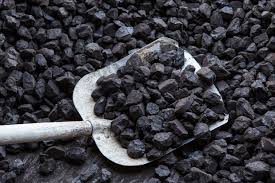 |
|
Anthracite, the
highest rank; a harder, glossy, black coal used primarily for
residential and commercial space heating. It
may be divided further into metamorphically altered bituminous coal and
petrified oil,
as from the deposits in Pennsylvania |
 |
|
Graphite,
technically the highest rank, but difficult to ignite and is not so
commonly used as fuel: it is mostly used in pencils and, when powdered,
as a
lubricant. |
 |
layers of rock
underground leads geologists to understand where to locate reserves of coal,
gold, oil, and many other useful minerals. Since coal is formed from
decayed plant material, which is covered by other rocks, geologists who look
for coal are well versed in sedimentary geology and structural geology.
The earliest reference to the use of
coal as fuel is from the geological treatise On stones (Lap. 16) by
the Greek
scientist
Theophrastus (c. 371–287 BC):
Among the materials that are dug because they are useful, those
known as coals are made of earth, and, once set on fire, they burn
like
charcoal. They are found in
Liguria ... and in
Elis as
one approaches
Olympia by the mountain road; and they are used by those who
work in metals.
Outcrop
coal was used in
Britain during the
Bronze
Age (3000–2000 BC), where it has been detected as forming part of the
composition of
funeral
pyres. In
Roman Britain, with the exception of two modern fields, "the
Romans were exploiting coals in all the major coalfields in
England
and Wales by
the end of the second century AD". Evidence of trade in coal (dated to about
AD 200) has been found at the
inland port of
Heronbridge, near
Chester,
and in the
Fenlands of
East
Anglia, where coal from the
Midlands was transported via the
Car Dyke
for use in drying grain. Coal cinders have been found in the hearths of
villas and
military forts, particularly in
Northumberland, dated to around AD 400. In the west of England
contemporary writers described the wonder of a permanent brazier of coal on
the altar of
Minerva at
Aquae
Sulis (modern day
Bath) although in fact easily accessible surface coal from what became
the
Somerset coalfield was in common use in quite lowly dwellings locally.
Evidence of coal's use for iron-working in the city during the Roman period
has been found. In
Eschweiler,
Rhineland,
deposits of
bituminous coal were used by the Romans for the smelting of
iron ore.
There is no evidence that the product was of great importance in Britain
before the
High Middle Ages, after about AD 1000.
Mineral
coal came to be referred to as "seacoal," probably because it came to many
places in eastern England, including
London, by
sea, but the origin of the term seems to predate this, being used for coal
having fallen from the exposed
coal seams on cliffs above the shore or washed out of underwater coal
seam outcrops. These easily
accessible sources had largely become exhausted (or could not meet the
growing demand) by the 13th century, when underground mining from
shafts or
adits
was developed.
In 1257-59 coal from Newcastle was shipped to London for the smiths and
lime-burners building
Westminster Abbey. In London there is still a Seacoal Lane and a
Newcastle Lane (from the coal-shipping city of
Newcastle) where in the seventeenth century coal was unloaded at wharves
along the
River
Fleet. An alternative name was "pitcoal," because it came from mines. It
was, however, the development of the
Industrial Revolution that led to the large-scale use of coal, as the
steam engine took over from the
water
wheel.
To learn more about
coal mining, visit
Coal Mining on Wikipedia.
End of Lesson

Return to the
Old Earth Ministries Online Earth
History Curriculum homepage.
Source:
Coal,
Carboniferous









